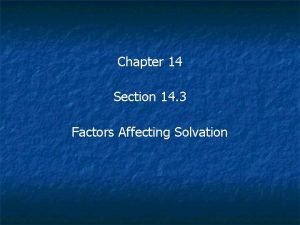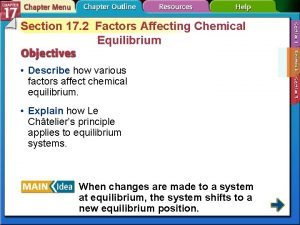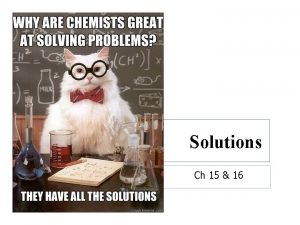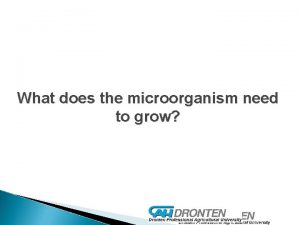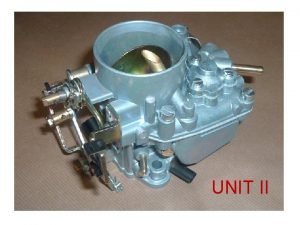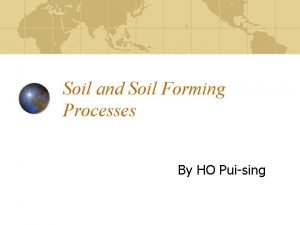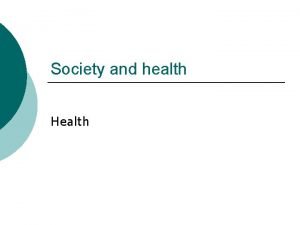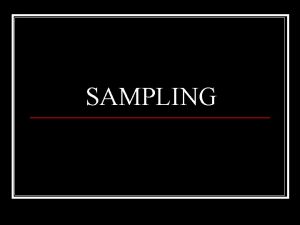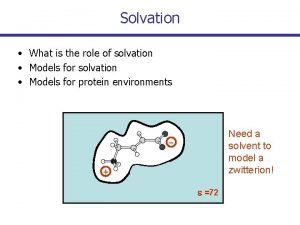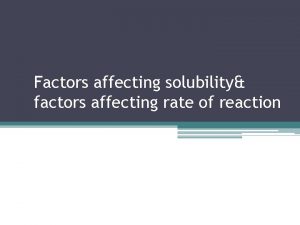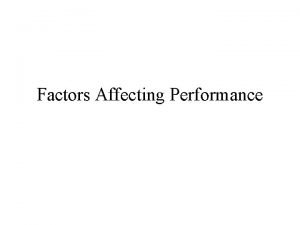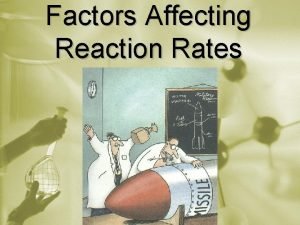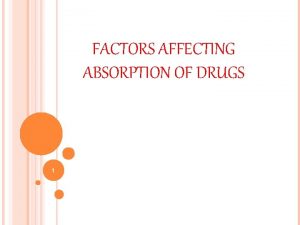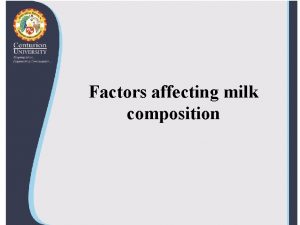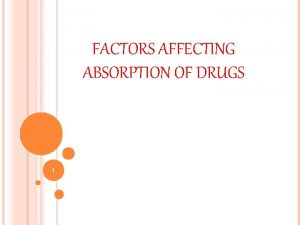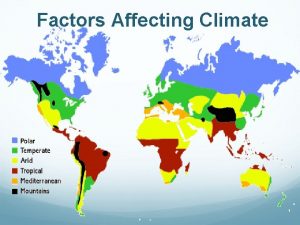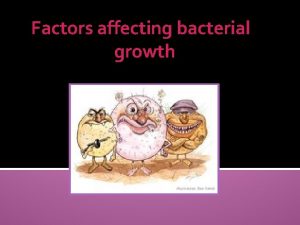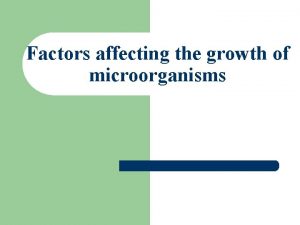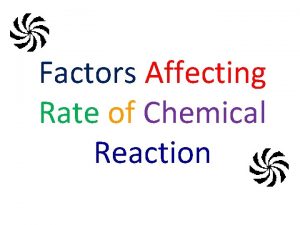Chapter 14 Section 14 3 Factors Affecting Solvation


















- Slides: 18

Chapter 14 Section 14. 3 Factors Affecting Solvation

Solvation: the process of surrounding solute particles with solvent particles to form a solution. Solvation in water is called hydration. “Like dissolves like” is the general rule used to determine whether solvation will occur in a specific solvent Like or not like in term of: A- bonding B- polarity of the particles C- the intermolecular forces among particles -

The Solvation Process Attractive forces exist between: 1 - the pure solute particles 2 - the pure solvent particles 3 - the solute and solvent particles. The Solvation Process: 1 - When a solid solute is placed in a solvent, the solvent particles completely surround the surface of the solid solute. 2 - If the attractive forces between the solvent and solute particles are greater than the attractive forces holding the solute particles together, the solvent particles pull the solute particles apart and surround them. 3 - These surrounded solute particles then move away from the solid solute and out into the solution.

Aqueous solutions of ionic compounds n n When a crystal of an ionic compound, such as sodium chloride (Na. Cl), is placed in water: 1 - the water molecules collide with the surface of the crystal. 2 - The charged ends of the water molecules attract the positive sodium ions and negative chloride ions. 3 - This attraction between the dipoles and the ions is greater than the attraction among the ions in the crystal, so the ions break away from the surface 4 - The water molecules surround the ions, and the solvated ions move into the solution shown in the Figure , exposing more ions on the surface of the crystal. Solvation continues until the entire crystal has dissolved.

Solvation Process of Na. Cl

Aqueous solutions of ionic compounds n n Q: Why some ionic substances do not solvate by water molecules? Because the attractive forces between ions of these ionic substances are so strong that they cannot be overcome by the attractive forces of the water molecules.

Aqueous solutions of molecular compounds Water is also a good solvent for many molecular compounds. Table sugar is the molecular compound sucrose. . As soon as the sugar crystals contact the water: 1 - water molecules collide with the outer surface of the crystal. 2 - Each O–H bond becomes a site for hydrogen bonding with water. 3 - The attractive forces among sucrose molecules are overcome by the attractive forces between polar water molecules and polar sucrose molecules. 4 - Sucrose molecules leave the crystal and become solvated by water molecules. See figure in the next slide 5 - Sucrose molecules contain eight O–H bonds and are polar. Polar water molecules form hydrogen bonds with the O–H bonds, which pulls the sucrose into solution.

TYPES OF MIXTURES Explain how dose Sucrose dissolve in water? Sucrose molecules contain eight O–H bonds and are polar. Polar water molecules form hydrogen bonds with the O–H bonds, which pulls the sucrose into solution.

Heat of solution n Heat of solution: The overall energy change that occurs during the solution formation process. During the process of solvation, the solute must separate into particles. Solvent particles must also move apart in order to allow solute particles to come between them. Energy is required to overcome the attractive forces within the solute and within the solvent, so both steps are endothermic. When solute and solvent particles mix, the particles attract each other and energy is released. This step in the solvation process is exothermic.

Factors That Affect Solvation n 1 -Agitation Stirring or shaking—agitation of the mixture—moves dissolved solute particles away from the contact surfaces more quickly and thereby allows new collisions between solute and solvent particles to occur. 2 - Surface area Breaking the solute into small pieces increases its surface area. A greater surface area allows more collisions to occur. This is why a teaspoon of granulated sugar dissolves more quickly than an equal amount of sugar in cube form. 3 - Temperature The rate of solvation is affected by temperature, as temperature increases, the rate of solvation of most solids also increases. Solvation of other substances, such as gases, decreases at higher temperatures.

Solubility n n Solubility: refers to the maximum amount of solute that can dissolve in a given amount of solvent at a particular temperature and pressure. When a solute is added to a solvent, solvent particles collide with the solute’s surface particles; solute particles begin to mix randomly among the solvent particles. At first, the solute particles are carried away from the crystal. However, as the number of solvated particles increases, the same random mixing results in increasingly frequent collisions between solvated solute particles and the remaining crystal.

Solubility n n n Crystallization: “against solubility” It is a process in which Some soluble colliding solute particles rejoin the crystal again. Every solubility process includes solvation and Crystallization As the rates of solvation and crystallization eventually equalize, no more solute appears to dissolve and a state of dynamic equilibrium exists between crystallization and solvation( at constant temperature)

n n In term of amount of solute in a solution there are Three types of solutions: 1 - unsaturated solution: is one that contains less dissolved solute for a given temperature and pressure than a saturated solution. 2 - Saturated solution: the overall amount of dissolved solute in the solution remains constant at equilibrium where rate of solvation equals rate of crystallization 3 - supersaturated solution contains more dissolved solute than a saturated solution at the same temperature. To make a supersaturated solution, a saturated solution is formed at a high temperature and then cooled slowly.

How? n n n Supersaturated solutions are unstable. If a tiny amount of solute, called a seed crystal, is added to a supersaturated solution, the excess solute precipitates quickly, as illustrated in Figure the fact that solubility changes with temperature and that some substances become more soluble with increasing temperature is the key to forming supersaturated solutions Crystallization can also occur if the inside of the container is scratched or the supersaturated solution undergoes a physical shock, such as stirring or tapping the container.

Temperature and supersaturated solutions n Solubility is affected by raising the temperature of the solvent because the kinetic energy of its particles is increased, resulting in more-frequent collisions and collisions with greater energy than those that occur at lower temperatures

Solubility of gases n n n Gases are less soluble in liquid solvents at high temperatures. Solubility of gases increases as its external pressure is increased. Henry’s law states that at a given temperature, the solubility (S) of a gas in a liquid is directly proportional to the pressure (P).

Questions n n n Q 1: If 0. 55 g of a gas dissolves in 1. 0 L of water at 20. 0 k. Pa of pressure, how much will dissolve at 110. 0 k. Pa pressure? 3 g/L Q 2: A gas has a solubility of 0. 66 g/L at 10 atm pressure. What is the pressure on a 1. 0 L sample that contains 1. 5 g of a gas? 23 atm Q 3: Describe how intermolecular forces affect solvation? The attractive forces between solute and solvent particles overcome the forces holding the solute particles together, thus, pulling the solute particles a part. Q 4: If a seed crystal was added to a supersaturated solution, how would you characterize the resulting solution? The resulting solution will be Saturated solution

End of section 14. 3
 What are the three factors that affect solvation
What are the three factors that affect solvation How do intermolecular forces affect solvation?
How do intermolecular forces affect solvation? Explain the factors affecting chemical equilibrium
Explain the factors affecting chemical equilibrium Henry's
Henry's Factors affecting climate
Factors affecting climate Factors affecting microbial growth in food
Factors affecting microbial growth in food Factor affecting volcanic eruption
Factor affecting volcanic eruption Factor affecting volcanic eruption
Factor affecting volcanic eruption Nozzle lip is provided in simple carburettor
Nozzle lip is provided in simple carburettor Factors affecting tga
Factors affecting tga V-list link
V-list link Factors affecting success of multilingualism
Factors affecting success of multilingualism Human movement science impact factor
Human movement science impact factor End diastolic volume meaning
End diastolic volume meaning Factors affecting movement in physical education
Factors affecting movement in physical education Baricity definition
Baricity definition Puising
Puising Factors affecting health
Factors affecting health Factors affecting sample size
Factors affecting sample size
